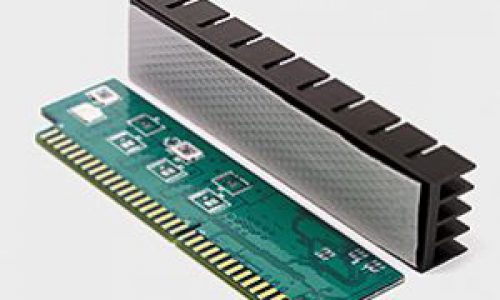Gap Pad
Gap Pad A2000
Features & Benefits
- Thermal conductivity: 2.0 W/m-K
- Fiberglass reinforced for puncture, shear and tear resistance
- Electrically isolating

Properties
| Properties | Imperial Value | Metric Value | Test Method |
|---|---|---|---|
| Reinforcement Carrier | Fiberglass | Fiberglass | *** |
| Color | Gray | Gray | Visual |
| Hardness (Bulk Rubber) (Shore 00) | 90 | 90 | ASTM D2240 |
| Typical Use Temp (°F) / (°C) | -76 to 356 | -60 to 180 | *** |
| Thickness (inch) / (mm) | 0.010 to 0.040 | 0.254 to 1.016 | ASTM D374 |
| Inherent Surface Tack (1 side) | 2 | 2 | *** |
| Elongation (%45° to Warp and Fill) | 40 | 40 | ASTM D412 |
| Density (Bulk Rubber) (g/cc) | 2.9 | 2.9 | ASTM D792 |
| Heat Capacity (J/g-K) | 1.0 | 1.0 | ASTM E1269 |
| Hardness(Bulk Rubber)(Shore 00) (1) | 80 | 80 | ASTM D2240 |
| Young's Modulus (psi) / (kPa) (2) | 55 | 379 | ASTM D575 |
| Continuous Use Temp (°F) / (°C) | -76 to 392 | -60 to 200 | *** |
| Electrical | Imperial Value | Metric Value | Test Method |
|---|---|---|---|
| Dielectric Breakdown Voltage (Vac) | >4000 | >4000 | ASTM D149 |
| Dielectric Constant (1000 Hz) | 6.0 | 6.0 | ASTM D150 |
| Volume Resistivity (Ohm-meter) | 10" | 10" | ASTM D257 |
| Flame Rating | V-O | V-O | U.L. 94 |
| Thermal | Imperial Value | Metric Value | Test Method |
|---|---|---|---|
| Thermal Conductivity (W/m-K) | 2.0 | 2.0 | ASTM D5470 |
| Deflection (% strain) | 10 | 20 | 30 |
|---|---|---|---|
| Thermal Impedance (°C-in2/W) 0.040" (3) | 1.04 | 1.00 | 0.95 |